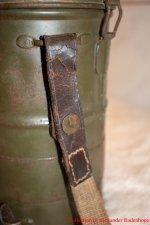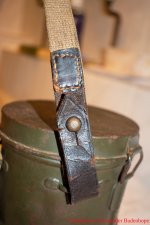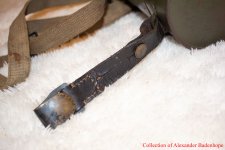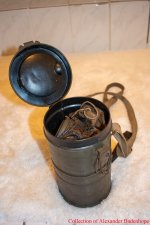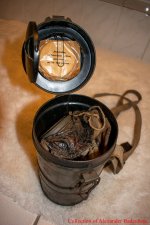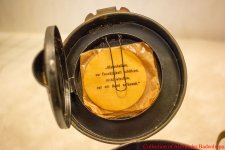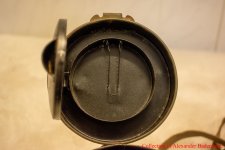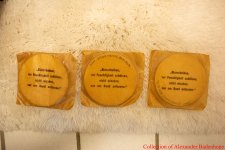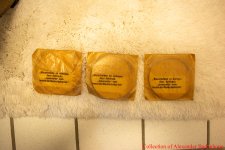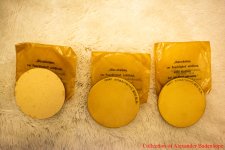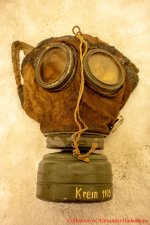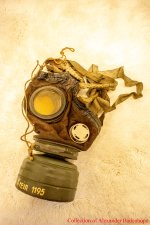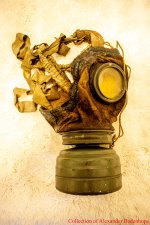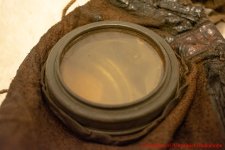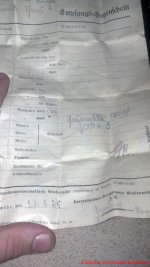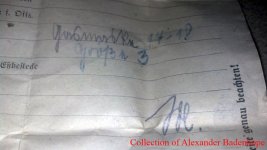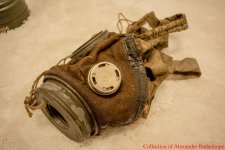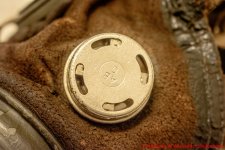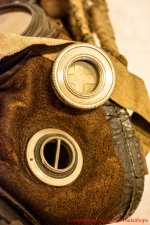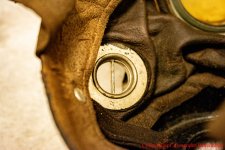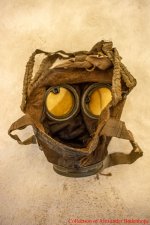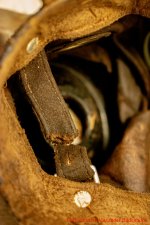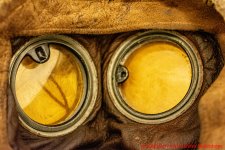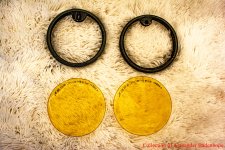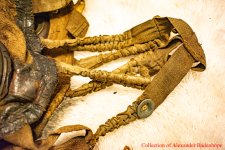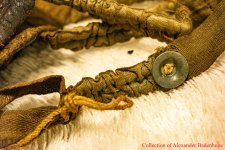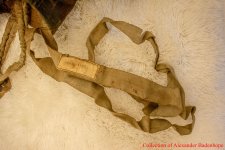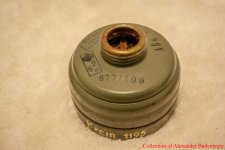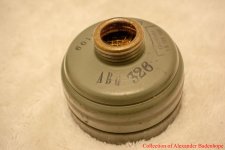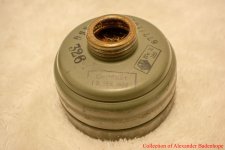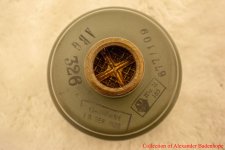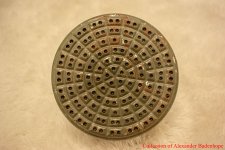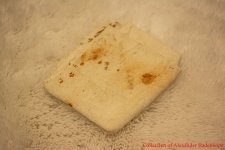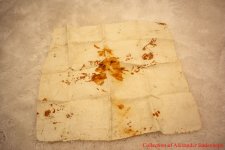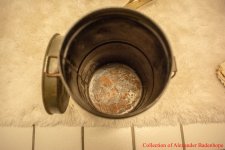Hello again Everyone,
Long time no see!
Due to my study program at the University of Bremen in History, I've had very little time (or money) for my collection for the past few years; however, I have been acquiring things here and there in spite of my lack of online presence and finally have found the time to share one of my rarer masks, a refurbished GM-18 in complete condition inside of its original carrier.
I originally purchased this mask from another collector in at the end of 2020; but, have only recently gotten around to taking photographs of it to share with the general public.
This set seems to have become rather famous among some people, as I've seen copies of the auction photographs of it shared on several forums. In-case anyone has been wondering exactly where it’s gone: It ended up in my collection! For those who have been curious about the set since they saw it for sale, I will finally share some general history and more detailed photographs of my own.
A short history lesson about the post war use of the GM-17 and GM-18 masks:
As is certainly common knowledge at this point, the various models of rubberized canvas masks used by the Germans in the early stages of World War I began to be replaced from mid-1917 onwards with protective masks constructed from leather. Today these masks are most often known in the English speaking world as the GM-17 and GM-18. As far as current research and surviving examples can tell us, after the conclusion of World War I the GM-17 and GM-18 masks that were in use by the Imperial German Military continued in service with the newly formed Reichswehr forces. Initially the masks were used in essentially the same configuration that was seen during the First World War, they still lacked exhale valves, had no modifications made to their face seals, and were used with stocks of existing filters left over from the Great War. The carriers for the masks were still used with the original carry straps and were not yet extended in length. At some point some of the original papercloth straps began being replaced with leather substitutes. This has been confirmed both by photographic evidence from the period, and by the discovery of a small number of Reichswehr marked GM-17 and GM-18 masks and carriers which have been found still in World War I configuration, with either original papercloth straps or leather substitutes. Sometime around 1930, most likely after the introduction of the GM-30 series of gas masks, the remaining GM-17 and GM-18 masks in Reichswehr inventory were "refurbished" through a centrally organized process to modernize their design in an effort to extend their service life. Such a plan most likely came about as a cost cutting measure to stretch a limited budget, or to overcome shortages of the GM-30 masks. The results of the program seem to have been the fitting of the remaining GM-17 and GM-18 masks with modified face seals which included a Kinnstütze, or chinrest, the installation of exhale valves, and in many cases, the replacement of the thinner World War I pattern carry straps with a stronger variant. The carriers for the masks were also modified by cutting them in into two halves and then welding a sheet metal cylinder in-between the halves in order to create a longer carrying case. The carrying cases also had their straps replaced at this point with leather ended canvas examples, with the belt hooks being made entirely out of leather with a metal hook attached at the end. This work appears to have been done exclusively by Auer, as all of the examples I have handled seem to have Auer produced exhale valves. These modified masks survived in inventory for quite some time, and there is some evidence to suggest that they were issued to rear echelon troops for a number of years before being turned over to the Luftschutz, or civil air defense. Later, many of the surviving masks were collected up and found their way to Spain and other “needy” countries as war aid, with a limited number of them remaining in Germany through some twist of fate. Unfortunately, no documents have surfaced, to my knowledge, which explain the timeline of ownership and the masks eventual fate; meaning that further research is needed in order to clarify their full history.
Turning our attention to my example, this particular mask was originally used by the Reichswehr and was modified by Auer, most likely in 1932. The mask then survived in use until at least 1938 with some German organization.
The set is rather special for a GM-17/18 reissue in that, the set is extensively marked with the owner's identifying information. As can be seen in the pictures below, at some point the mask was issued to someone with the last name of "Krein"; hence, I have taken to calling this particular set the "Krein Maske" since acquiring it. The last name is accompanied by a four digit number “1195” across the entirety of the set. This is obviously some kind of identification number for its owner; however, my knowledge of German organization identification numbers is practically non-existent. Thus, it is possible that the number’s length could possibly help us to identify the final German organization which used the mask; however, I am unable to attach any meaning to it personally.
Without further delay, I will now present my photographs of this particular example. I hope you all are ready for one of my typical, photo heavy, posts!
Starting with the Tragbüchse, or "carrying case" it is possible to observe that the majority of the deep green paint has survived well over the years along with both the short and long Tragriemen, or "carrying straps". It is rather unusual to find these reissued GM-17/18 carriers in such a condition for some reason. The majority of them are found missing most of their paint and with relatively strong corrosion problems, the cylinder shaped "extension" that was welded into the recycled carriers seems to be particularly vulnerable to this phenomenon, as they are almost always the first area of the cylinder to become barren of paint and corrode, more than likely a difference in the makeup of the steel or it's preperation is to blame for this.
Below: Various Views of the Carrying Case with it's lid both open and closed. The outside of the container is painted the same deep green as World War I examples, and the inside is the same matte black.
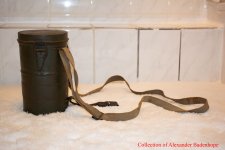
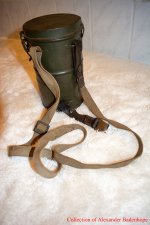
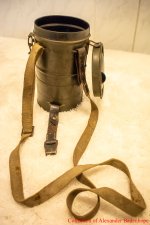
Below: The metal cylinder which has been added to the carrier to extend its lenght is clearly visible here, near the bottom of the carrying case.
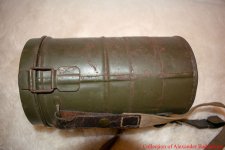
Below: Details of the latch that holds the lid closed and the hinge on the opposite side of the carrying case. the "J" in the circle marking denotes the original manufacturer of the carrier and dates to World War I.
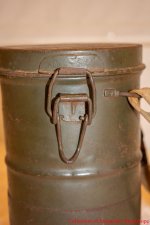
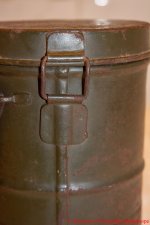
Below: Visible faintly on the lid of the carrier is an etched name. The etching is too faint to read without more detailed analysis than I have already conducted. More than likely this etching was done after the carrier was converted, as it would not have survived the refurbishment process.
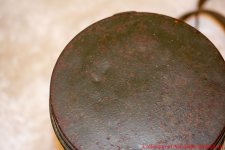
Below: The name "Krein" and the identification number "1195" brushed onto the bottom of the carrying case in white paint.
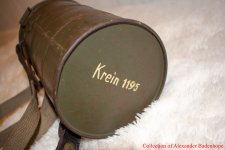
Long time no see!
Due to my study program at the University of Bremen in History, I've had very little time (or money) for my collection for the past few years; however, I have been acquiring things here and there in spite of my lack of online presence and finally have found the time to share one of my rarer masks, a refurbished GM-18 in complete condition inside of its original carrier.
I originally purchased this mask from another collector in at the end of 2020; but, have only recently gotten around to taking photographs of it to share with the general public.
This set seems to have become rather famous among some people, as I've seen copies of the auction photographs of it shared on several forums. In-case anyone has been wondering exactly where it’s gone: It ended up in my collection! For those who have been curious about the set since they saw it for sale, I will finally share some general history and more detailed photographs of my own.
A short history lesson about the post war use of the GM-17 and GM-18 masks:
As is certainly common knowledge at this point, the various models of rubberized canvas masks used by the Germans in the early stages of World War I began to be replaced from mid-1917 onwards with protective masks constructed from leather. Today these masks are most often known in the English speaking world as the GM-17 and GM-18. As far as current research and surviving examples can tell us, after the conclusion of World War I the GM-17 and GM-18 masks that were in use by the Imperial German Military continued in service with the newly formed Reichswehr forces. Initially the masks were used in essentially the same configuration that was seen during the First World War, they still lacked exhale valves, had no modifications made to their face seals, and were used with stocks of existing filters left over from the Great War. The carriers for the masks were still used with the original carry straps and were not yet extended in length. At some point some of the original papercloth straps began being replaced with leather substitutes. This has been confirmed both by photographic evidence from the period, and by the discovery of a small number of Reichswehr marked GM-17 and GM-18 masks and carriers which have been found still in World War I configuration, with either original papercloth straps or leather substitutes. Sometime around 1930, most likely after the introduction of the GM-30 series of gas masks, the remaining GM-17 and GM-18 masks in Reichswehr inventory were "refurbished" through a centrally organized process to modernize their design in an effort to extend their service life. Such a plan most likely came about as a cost cutting measure to stretch a limited budget, or to overcome shortages of the GM-30 masks. The results of the program seem to have been the fitting of the remaining GM-17 and GM-18 masks with modified face seals which included a Kinnstütze, or chinrest, the installation of exhale valves, and in many cases, the replacement of the thinner World War I pattern carry straps with a stronger variant. The carriers for the masks were also modified by cutting them in into two halves and then welding a sheet metal cylinder in-between the halves in order to create a longer carrying case. The carrying cases also had their straps replaced at this point with leather ended canvas examples, with the belt hooks being made entirely out of leather with a metal hook attached at the end. This work appears to have been done exclusively by Auer, as all of the examples I have handled seem to have Auer produced exhale valves. These modified masks survived in inventory for quite some time, and there is some evidence to suggest that they were issued to rear echelon troops for a number of years before being turned over to the Luftschutz, or civil air defense. Later, many of the surviving masks were collected up and found their way to Spain and other “needy” countries as war aid, with a limited number of them remaining in Germany through some twist of fate. Unfortunately, no documents have surfaced, to my knowledge, which explain the timeline of ownership and the masks eventual fate; meaning that further research is needed in order to clarify their full history.
Turning our attention to my example, this particular mask was originally used by the Reichswehr and was modified by Auer, most likely in 1932. The mask then survived in use until at least 1938 with some German organization.
The set is rather special for a GM-17/18 reissue in that, the set is extensively marked with the owner's identifying information. As can be seen in the pictures below, at some point the mask was issued to someone with the last name of "Krein"; hence, I have taken to calling this particular set the "Krein Maske" since acquiring it. The last name is accompanied by a four digit number “1195” across the entirety of the set. This is obviously some kind of identification number for its owner; however, my knowledge of German organization identification numbers is practically non-existent. Thus, it is possible that the number’s length could possibly help us to identify the final German organization which used the mask; however, I am unable to attach any meaning to it personally.
Without further delay, I will now present my photographs of this particular example. I hope you all are ready for one of my typical, photo heavy, posts!
Starting with the Tragbüchse, or "carrying case" it is possible to observe that the majority of the deep green paint has survived well over the years along with both the short and long Tragriemen, or "carrying straps". It is rather unusual to find these reissued GM-17/18 carriers in such a condition for some reason. The majority of them are found missing most of their paint and with relatively strong corrosion problems, the cylinder shaped "extension" that was welded into the recycled carriers seems to be particularly vulnerable to this phenomenon, as they are almost always the first area of the cylinder to become barren of paint and corrode, more than likely a difference in the makeup of the steel or it's preperation is to blame for this.
Below: Various Views of the Carrying Case with it's lid both open and closed. The outside of the container is painted the same deep green as World War I examples, and the inside is the same matte black.



Below: The metal cylinder which has been added to the carrier to extend its lenght is clearly visible here, near the bottom of the carrying case.

Below: Details of the latch that holds the lid closed and the hinge on the opposite side of the carrying case. the "J" in the circle marking denotes the original manufacturer of the carrier and dates to World War I.


Below: Visible faintly on the lid of the carrier is an etched name. The etching is too faint to read without more detailed analysis than I have already conducted. More than likely this etching was done after the carrier was converted, as it would not have survived the refurbishment process.

Below: The name "Krein" and the identification number "1195" brushed onto the bottom of the carrying case in white paint.


